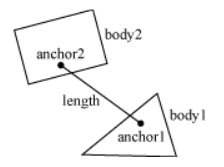Difference between revisions of "love.physics.newDistanceJoint"
Antoniomoder (talk | contribs) (add image) |
Antoniomoder (talk | contribs) m (add "world space") |
||
| Line 14: | Line 14: | ||
{{param|Body|body1|The first body to attach to the joint.}} | {{param|Body|body1|The first body to attach to the joint.}} | ||
{{param|Body|body2|The second body to attach to the joint.}} | {{param|Body|body2|The second body to attach to the joint.}} | ||
| − | {{param|number|x1|The x position of the first anchor point.}} | + | {{param|number|x1|The x position of the first anchor point (world space).}} |
| − | {{param|number|y1|The y position of the first anchor point.}} | + | {{param|number|y1|The y position of the first anchor point (world space).}} |
| − | {{param|number|x2|The x position of the second anchor point.}} | + | {{param|number|x2|The x position of the second anchor point (world space).}} |
| − | {{param|number|y2|The y position of the second anchor point.}} | + | {{param|number|y2|The y position of the second anchor point (world space).}} |
{{param|boolean|collideConnected (false)|Specifies whether the two bodies should collide with each other.}} | {{param|boolean|collideConnected (false)|Specifies whether the two bodies should collide with each other.}} | ||
=== Returns === | === Returns === | ||
| Line 31: | Line 31: | ||
{{param|Body|body1|The first body to attach to the joint.}} | {{param|Body|body1|The first body to attach to the joint.}} | ||
{{param|Body|body2|The second body to attach to the joint.}} | {{param|Body|body2|The second body to attach to the joint.}} | ||
| − | {{param|number|x1|The x position of the first anchor point.}} | + | {{param|number|x1|The x position of the first anchor point (world space).}} |
| − | {{param|number|y1|The y position of the first anchor point.}} | + | {{param|number|y1|The y position of the first anchor point (world space).}} |
| − | {{param|number|x2|The x position of the second anchor point.}} | + | {{param|number|x2|The x position of the second anchor point (world space).}} |
| − | {{param|number|y2|The y position of the second anchor point.}} | + | {{param|number|y2|The y position of the second anchor point (world space).}} |
=== Returns === | === Returns === | ||
{{param|DistanceJoint|joint|The new distance joint.}} | {{param|DistanceJoint|joint|The new distance joint.}} | ||
Revision as of 00:36, 6 December 2016
Creates a DistanceJoint between two bodies.
This joint constrains the distance between two points on two bodies to be constant. These two points are specified in world coordinates and the two bodies are assumed to be in place when this joint is created. The first anchor point is connected to the first body and the second to the second body, and the points define the length of the distance joint.
Contents
Function
| Available since LÖVE 0.8.0 |
| This variant is not supported in earlier versions. |
Synopsis
joint = love.physics.newDistanceJoint( body1, body2, x1, y1, x2, y2, collideConnected )
Arguments
Body body1- The first body to attach to the joint.
Body body2- The second body to attach to the joint.
number x1- The x position of the first anchor point (world space).
number y1- The y position of the first anchor point (world space).
number x2- The x position of the second anchor point (world space).
number y2- The y position of the second anchor point (world space).
boolean collideConnected (false)- Specifies whether the two bodies should collide with each other.
Returns
DistanceJoint joint- The new distance joint.
Function
| Removed in LÖVE 0.8.0 |
| This variant is not supported in that and later versions. |
Synopsis
joint = love.physics.newDistanceJoint( body1, body2, x1, y1, x2, y2 )
Arguments
Body body1- The first body to attach to the joint.
Body body2- The second body to attach to the joint.
number x1- The x position of the first anchor point (world space).
number y1- The y position of the first anchor point (world space).
number x2- The x position of the second anchor point (world space).
number y2- The y position of the second anchor point (world space).
Returns
DistanceJoint joint- The new distance joint.
See Also
Other Languages
Dansk –
Deutsch –
English –
Español –
Français –
Indonesia –
Italiano –
Lietuviškai –
Magyar –
Nederlands –
Polski –
Português –
Română –
Slovenský –
Suomi –
Svenska –
Türkçe –
Česky –
Ελληνικά –
Български –
Русский –
Српски –
Українська –
עברית –
ไทย –
日本語 –
正體中文 –
简体中文 –
Tiếng Việt –
한국어
More info
